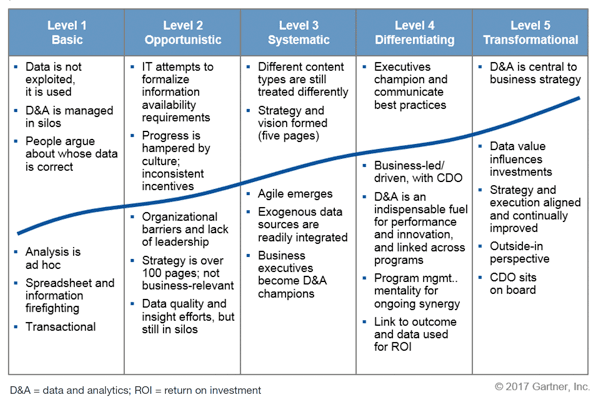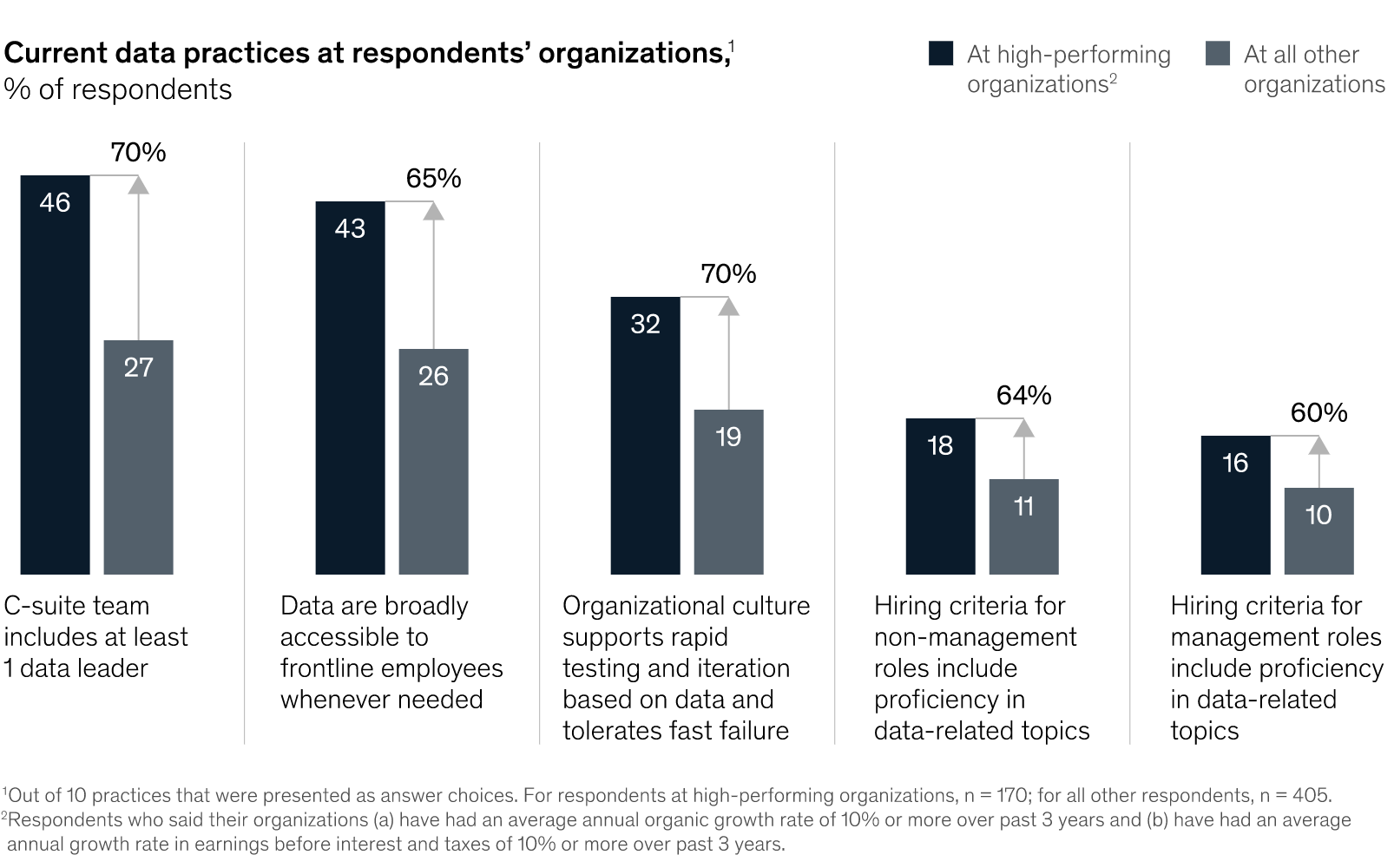In the 21st century, data is the fuel for every kind of revenue engine. The good news is that an overwhelming majority of companies are recognizing this fact: over 90% of executives reported in a NewVantage Partners study that the pace of big data and AI investment was accelerating at their companies.
Yet, less than half of them reported that they satisfactorily manage data as a business asset, have forged a data culture, or have created a data-driven organization.
 Source:1
Source:1
Clearly, companies are struggling to realize the value of their data. Building a data-driven organization requires more than increased investment on data projects. What’s missing or even poorly defined in most cases is a robust data strategy.
In the simplest terms, a data strategy is an enterprise-wide plan for managing data to generate value. Importantly, a data strategy is more than just an IT project for data processing and database management. Rather, it is a comprehensive plan involving a common set of goals, objectives, and resources for the efficient and effective use of data across projects.
Here are five reasons why every company needs a data strategy:
1. A data-strategy maps the journey of a data-driven organization
Trying to unleash the power of your data is meaningless, if you don’t have a clear sense of what this power should achieve. Data can only be meaningful in response to clear questions or problems defined by an organization’s business strategy. Separating information from noise depends on the nature of goals outlined by the data strategy. Broadly, these goals can be grouped into three categories:
Product development/innovation goals focus on aggressively leveraging data sources for generating new revenue streams and maintaining competitive advantage. This could include creating new products or services, reengineering user experiences, adapting to changes in market/competition, and monetizing data.
Operational or process improvements focus internally on optimizing efficiency, improving quality and/or reducing costs. Examples include leveraging new data sources, optimizing analytics capabilities, using data to improve infrastructure, reduce operating costs, or improve revenue through cross-selling, pricing and expanding the customer base.
Compliance or governance goals focus on externally on adhering to regulatory regimes as well as internally on ensuring the integrity and quality of data. These include complying with industry frameworks for data security and privacy, preventing cyber attacks or data theft, tackling fraud, rationalizing multiple data sources, and improving data quality.
Depending on the goals and priorities for each organization, a data strategy should also define a comprehensive set of KPIs and use cases that concretize its vision and provide clear milestones for progress.
2. A data strategy helps drive clarity and resolve conflicts among priorities
As the list above suggests, data can be leveraged for a wide set of priorities, each requiring a different, and often contradictory, set of tactics for data acquisition, storage, management, sharing and usage. A data strategy, therefore, is necessary to clarify the purposes for which data is deployed and resolve conflicts among clashing priorities. Many of these conflicts are inter-related, such as:
Control versus freedom: From a governance perspective, uniformity breeds consistency, compliance, and integrity, and minimizes risk. However, from a business/functional perspective, freedom allows faster, more flexible and more effective responses to changes in market conditions or customer requirements.
Centralization versus decentralization: Decentralized data operations can lead to rapid experimentation boosting agility and responsiveness. However, building stability, scalability, and the standardization needed for repeatability requires centralization.
Optimization versus innovation: Optimization relies on existing frameworks and processes, proven approaches and a wider deployment of bottom-line data capabilities for efficiency and cost improvements. On the other hand, innovation relies on power users focused on previously unexplored terrain, using unproven approaches and a higher risk quotient.
None of these conflicts can be solved with a binary either-or approach. A data strategy must innovatively negotiate compromises between these different priorities based on the specific state of the art of each company.
3. A data strategy defines the roadmap for evolution
Data and analytics maturity does not arrive overnight. Take the maturity model proposed by Gartner Inc, for instance.
 Source:2
Source:2
In its 2017 survey, Gartner found that over half of organizations remained in the second and third levels of data maturity, and only 9% ranked themselves in the highest level. And one of the most common barriers to achieving higher levels of maturity—defining a data and analytics strategy.
A data strategy is integral for mapping this evolution to maturity and laying down the necessary milestones and change management strategies. Without such strategic planning, organizations remain hampered in their data efforts.
4. A data strategy defines the operational elements for scalable infrastructure, architecture and governance
Big data comes with multiple complexities thanks to the burgeoning volume and sources of data as well as the rapid evolution of new technologies. Organizations must therefore plan for current and future data needs, as they cannot undergo slowdowns due to legacy infrastructure or lag times in deploying new technologies.
Organizations, therefore, require a scalable data architecture, the technological blueprint defining the steps involved in acquiring, storing, sharing, processing, and analyzing data. Such a data architecture also requires adequate technological infrastructure in order to cope with changing data demands. A data strategy is necessary to define the current infrastructural state of the organization and maps its future technological trajectory.
5. A data strategy defines the milestones to building a data culture
Returning to the NewVantage Partners study we began with, we find that over 90% of organizations list people and processes as the principal challenge to becoming data driven. Similarly, a recent McKinsey survey found significant differences between high-performing and other organizations in building an organizational culture suited to fully integrating data into core business processes.
 Source:3
Source:3
Such a data culture does not get built automatically. Rather, it is necessary for organizations to identify important stakeholders, establish key roles and responsibilities, define the values and guiding principles for personnel at all levels, and develop strategies for building awareness about data initiatives within the organization, another key function of the data strategy.
A data strategy isn’t a nice-to-have add-on, it’s a necessity for survival
Gone are the days when data was simply an ignored by-product of business processes. It is now a central strategic asset. While we have taken decades to reach the current level of data saturation, data volumes will continue to rise exponentially.
For companies that treat data strategy as an after-thought, it is going to be challenging to drive sustainable and meaningful change. Managing and optimizing business performance have become, in this age of digital transformation, essential to business competitiveness and survival. Now more than ever, facilitating effective data driven decisions is synonymous with business success.
- https://newvantage.com/wp-content/uploads/2018/12/Big-Data-Executive-Survey-2019-Findings-Updated-010219-1.pdf [return]
- https://www.gartner.com/en/newsroom/press-releases/2018-02-05-gartner-survey-shows-organizations-are-slow-to-advance-in-data-and-analytics [return]
- https://www.mckinsey.com/business-functions/mckinsey-analytics/our-insights/catch-them-if-you-can-how-leaders-in-data-and-analytics-have-pulled-ahead#interactive [return]








